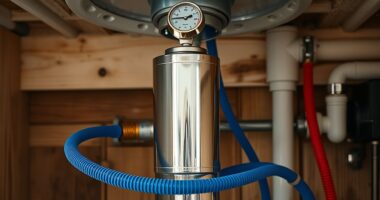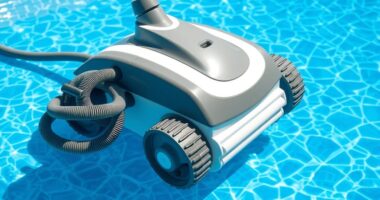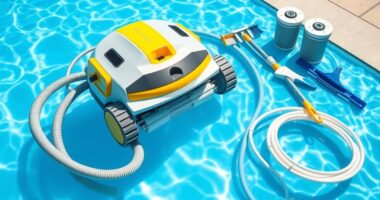Automatic pool cleaners are great for removing routine debris like dirt, leaves, and waterline buildup. However, they can’t fully tackle algae or stubborn cloudiness on their own. Algae cling to surfaces and thrive from imbalanced water, which requires manual cleaning and chemical treatment. While robotic cleaners help maintain clarity when combined with proper water chemistry, they shouldn’t replace other essential maintenance steps. To discover how to keep your pool sparkling, keep exploring the options available.
Key Takeaways
- Robotic pool cleaners excel at removing surface debris but cannot directly treat algae or clear stubborn cloudiness.
- They are most effective when used alongside chemical treatments like chlorine and algaecides.
- Robotic cleaners help remove debris that contributes to cloudiness, supporting water clarity efforts.
- Manual cleaning, brushing, and proper water chemistry are essential for controlling algae and improving clarity.
- Combining robotic cleaning with regular maintenance ensures healthier, clearer pool water.

Automatic pool cleaners have revolutionized how you maintain a clean and inviting swimming pool. They use advanced robotic technology to simplify the cleaning process, eliminating much of the manual effort you once had to invest. Instead of spending hours scrubbing and skimming, you can rely on these devices to keep your pool pristine. While they excel at removing dirt, leaves, and debris, their ability to handle algae and cloudy water is a different story altogether. Understanding their capabilities helps you decide whether they’re the right solution for your specific pool issues.
Most robotic pool cleaners are designed primarily for routine cleaning tasks. They excel at vacuuming the floor, walls, and waterline, making your pool look fresh and inviting. However, when it comes to algae blooms or cloudy water, the situation gets a bit more complex. Algae often cling to surfaces and thrive in conditions that basic robotic cleaners might not fully address. These devices are excellent at removing surface debris, but they don’t typically contain the specialized features needed to treat algae or clear up stubborn cloudiness. That’s where manual cleaning and chemical balancing come into play. You’ll still need to brush the pool walls, scrub corners, and adjust water chemistry to control algae growth effectively.
Robotic cleaners handle routine tasks but need manual efforts for algae and cloudiness.
Cloudy water often results from imbalanced pH levels, inadequate filtration, or residual algae particles suspended in the water. While robotic cleaners can help by removing debris that may contribute to cloudiness, they don’t replace the need for chemical treatment and proper filtration. If your pool is cloudy due to algae, you’ll want to shock the water with chlorine or other algaecides first, then run your robotic cleaner to remove residual debris. This combined approach offers the best chance to restore clarity. Keep in mind that robotic technology can assist in cleaning, but it isn’t a substitute for proper water chemistry management. Additionally, regular maintenance such as cleaning filters and testing water chemistry is essential to prevent future issues.
Manual cleaning remains essential when dealing with algae and cloudy pools. Brushing the surfaces to dislodge algae and vacuuming manually can often be necessary before running your robotic cleaner. Regular maintenance, such as testing water chemistry and cleaning filters, plays a vital role in preventing these issues from recurring. Proper water chemistry and filtration systems work together to keep your pool clear and safe. Additionally, maintaining proper water chemistry helps ensure your pool remains clear and healthy. While robotic pool cleaners considerably reduce your workload, they are most effective when used as part of a thorough pool care routine that includes manual cleaning and chemical balancing. This combined effort ensures your pool stays not just clean-looking but also safe and healthy for swimming.
Frequently Asked Questions
Can Automatic Pool Cleaners Remove Algae From Pool Walls?
Automatic pool cleaners can help with pool wall maintenance, but they might not fully eradicate algae. For effective algae removal techniques, you’ll need to scrub the walls manually or use a specialized algae brush. While some automatic cleaners can loosen surface algae, they often can’t completely eliminate it. Combining manual cleaning with proper chemical treatment ensures your pool stays clean and algae-free.
How Effective Are Automatic Cleaners on Cloudy Water?
Imagine your pool, cloudy like a foggy morning, and you wonder if your automatic cleaner can clear it up. While these cleaners help by scrubbing surfaces, they often fall short with cloudy water. Filter efficiency plays a key role, but maintenance challenges like clogged filters can limit effectiveness. You might need to supplement with chemical treatments or manual cleaning to fully restore clarity and guarantee your pool stays inviting.
Do Automatic Pool Cleaners Require Chemical Treatment for Algae?
You don’t necessarily need chemical treatment for algae when using an automatic pool cleaner, but it’s recommended for best results. Proper chemical balancing keeps your water clear and prevents algae growth. While the cleaner helps remove debris, manual brushing is often necessary to scrub algae off surfaces. Regular chemical adjustments combined with your cleaner’s efforts will maintain a healthy, algae-free pool, reducing the need for extensive chemical treatments later.
Are Automatic Pool Cleaners Suitable for All Pool Types?
You might think automatic pool cleaners handle every pool type perfectly, but surprise! Robotic maintenance isn’t a magic wand for perfect pool chemistry. While they sweep debris and scrub surfaces, they don’t fix algae or cloudiness caused by imbalanced chemicals. So, yes, your pool’s type matters. You’ll still need to manage chemical levels, especially if you want your cleaner to do its job without turning into a floating algae farm.
How Often Should I Run My Automatic Cleaner During Algae Blooms?
During algae blooms, you should run your automatic pool cleaner more frequently, ideally daily, to improve cleaning frequency and tackle algae prevention. This helps remove algae and debris before they spread. Regular use guarantees your pool stays clear and reduces chemical treatments needed later. Keep a close eye on water quality and adjust cleaning schedules accordingly, especially during intense algae growth, to maintain a healthy, inviting pool.
Conclusion
While automatic pool cleaners excel at removing debris and dirt, they often struggle with algae and cloudy water. Did you know that over 60% of pool owners report algae issues during peak season? Investing in a good filtration system and regular chemical treatments can make a huge difference. So, while cleaners help keep your pool tidy, tackling algae and cloudiness requires a combination of proper maintenance and manual intervention for crystal-clear water all season long.









